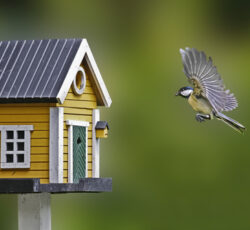 Having birds and butterflies visit your landscape can be a wonderful experience. Not only do these creatures add beauty to your surroundings, but they also play a crucial role in pollination and helping to maintain a healthy ecosystem. If you’re interested in attracting birds and butterflies to your landscape, here are some tips to help you create a welcoming habitat for them.
Having birds and butterflies visit your landscape can be a wonderful experience. Not only do these creatures add beauty to your surroundings, but they also play a crucial role in pollination and helping to maintain a healthy ecosystem. If you’re interested in attracting birds and butterflies to your landscape, here are some tips to help you create a welcoming habitat for them.
1. Provide a water source
One of the most important factors in attracting birds and butterflies is having a reliable water source. You can consider installing a birdbath or a small pond that provides fresh water for them to drink and bathe in. Make sure to clean and refill the water regularly to maintain its freshness.
2. Plant native species
Birds and butterflies are naturally attracted to native plants that provide them with food and shelter. Research the native plants in your region and incorporate them into your landscape design. Native plants are not only beautiful but are also better adapted to the local climate and require less maintenance.
3. Create different habitats
Birds and butterflies require different types of habitats for nesting, feeding, and resting. By diversifying your landscape, you can cater to the needs of various species. Planting a mix of trees, shrubs, and flowering plants, along with creating different layers of vegetation, will attract a wider variety of birds and butterflies.
4. Provide food sources
To attract birds, consider planting fruit-bearing trees or shrubs such as blackberries, elderberries, or holly. These provide a natural source of food for both birds and butterflies. Additionally, incorporating nectar-rich flowers like butterfly bush, coneflower, or zinnias will attract butterflies and provide them with the energy they need.
5. Offer shelter and nesting areas
Birds and butterflies need safe spaces to nest and take shelter from predators and harsh weather conditions. Incorporate birdhouses, nesting boxes, and butterfly houses in your landscape to provide them with a secure place to rest and raise their young. Ivy-covered trellises, tall grasses, and dense shrubs can also serve as natural shelters.
6. Avoid pesticide use
Pesticides can be harmful to birds and butterflies, as well as other beneficial insects. Instead of relying on chemical solutions, consider natural alternatives to control pests in your landscape. Encourage the presence of natural predators like ladybugs and praying mantises, and use organic pest control methods if necessary.
7. Provide feeders and supplemental food
Adding bird feeders to your landscape can attract a variety of bird species. Place feeders in a quiet and safe location, away from windows, where birds can easily access them. Remember to clean the feeders regularly to prevent the spread of diseases. You can also offer supplemental food like oranges or sugar water in feeders specifically designed for butterflies.
8. Create a welcoming environment
Birds and butterflies are more likely to visit landscapes that are inviting and safe. Minimize noise and disturbance, and create a calm and peaceful atmosphere. Avoid using excessive outdoor lighting at night, as it can disorient migrating birds and disrupt their natural patterns.
Conclusion
Attracting birds and butterflies to your landscape requires dedication and patience. It may take some time for them to discover your garden and feel comfortable enough to make it their home. By implementing these tips and providing a suitable environment, you can enjoy the beauty of these creatures and contribute to the conservation of their populations.

